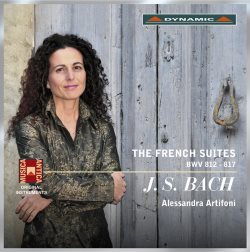| 
|
Johann Sebastian BACH (1685 - 1750)
The French Suites (BWV 812-817)
Suite No. 1 in d minor (BWV 812) [14:24]
Suite No. 2 in c minor (BWV 813) [13:54]
Suite No. 3 in b minor (BWV 814) [13:59]
Suite No. 4 in E flat (BWV 815) [13:34]
Suite No. 5 in G (BWV 816) [17:40]
Suite No. 6 in E (BWV 817) [15:32]
Alessandra Artifoni (harpsichord)
rec. July 2012, Villa L'Oriuolo, Florence, Italy. DDD
DYNAMIC CDS 757/1-2 [45:08 + 45:36]
The suite, a form of French origin, was introduced in Germany around the middle of the 17th century. It was Johann Jacob Froberger who laid down the pattern which was to become the standard, with a sequence of allemande, courante, sarabande and gigue. In this respect it was clearly different from the French suite which was a rather loose collection of dances in the same key from which performers could make a selection.
Bach composed a large number of suites - sometimes called partita - in which he followed the basic structure mentioned above, but mostly extended them with other dances. This could be a prelude at the opening of a suite, which reflects his acquaintance with the French idiom of his time. Later in his career he also added other dance types, such as gavotte, bourrée and menuet. On the title-page of his Clavier-Übung I Bach uses the word Galanterien to describe these dances, and this suggests a reference to the galant idiom. However, it seems that this was a more general term for dances of various types.
Even so, it cannot be denied that the some of Bach's suites show his interest in the galant idiom, and that goes especially for the six French Suites. There is far less use of counterpoint here than in other keyboard music. The closing gigues of the first three suites are the main exceptions as they are all fugues. Bach started to compose these suites in the early 1720s: the first versions of some of them were included in the Clavierbüchlein for Anna Magdalena Bach. Copies have survived in the hands of some of his pupils and this - in combination with the rather light style - has led to the assumption that they were meant as educational material. The name French Suites is not from Bach's pen but was conferred by Friedrich Wilhelm Marpurg in 1762. This could lead to the misunderstanding that they are specific specimens of the influence of the French style in Bach's music. In fact it has been argued that the English Suites are closer to the French style than the French Suites. These also include elements of the Italian style.
There is no lack of recordings. Some performers need only one disc, but that is only possible by omitting some of the repeats. Alessandra Artifoni plays all the repeats, apparently with the exception of the menuet of Suite No. 2. Her tempi are on the fast side which is not a problem, but in this case it results in less than satisfactory articulation. I find her playing rather straightforward, with little breathing spaces, for instance between phrases, but also within phrases. This also means that there are few dynamic accents and too little differentation between the notes. The rhythmic pulse which is so important in dances doesn't come off all that well.
Ms Artifoni plays a beautiful instrument, a copy after Michael Mietke from 1702/04. That seems a most appropriate choice, more so than a French-type instrument. It has also been recorded very well, with miking that is just right. However, the interpretation leaves me rather unsatisfied and for this reason I can't rate this performance among the best.
Johan van Veen
http://www.musica-dei-donum.org
https://twitter.com/johanvanveen
 |
 |
|
